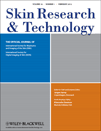Buffering capacity of human skin layers: in vitro
Abstract
Background/purpose: The skin possesses buffering capacity to resist acidic/alkaline aggression. Skin components contribute differently to this buffering capacity. This study investigates buffering capacity in three skin layers: intact stratum corneum (SC), epidermis and dermis.
Methods: Sodium hydroxide (NaOH) and hydrochloric acid (HCl) solutions at 0.025, 0.05 and 0.1 N were applied to skin (3.18 μL/cm2). After 30 min, the skin was washed with 1 mL de-ionized water. TEWL and pH measurements were conducted at baseline (before contact with acid or base), 0, 10 and 30 min post exposure, and continued at 0, 10 and 30 min post washing.
Results: Data indicate that immediately following acid or base exposures, the dermis demonstrates the highest buffering capacity, while with time, intact stratum corneum predominates.
Conclusion: These findings potentiate advanced understanding of skin's buffering capacity as related to dermatopharmacology and dermatotoxicology.




